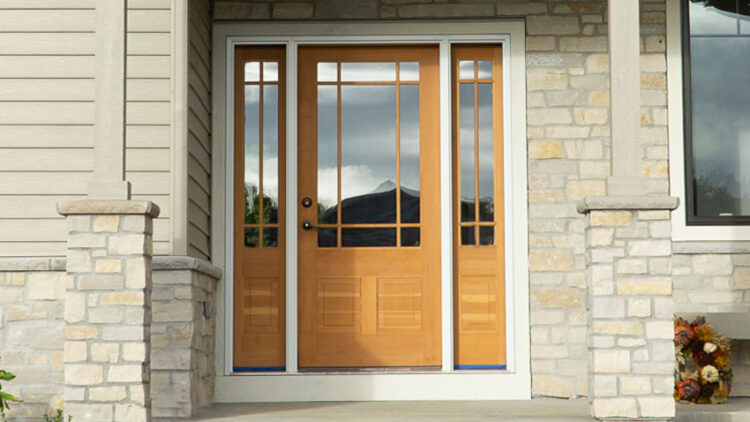WHAT TO LOOK FOR BEHIND NEW DOORS
Regardless if you’re building new or replacing the old, your options for doors are significant. From styles to materials, there are more choices than ever—whether you’re looking for an everyday, utilitarian door or one that makes a statement. So, let’s take a look at the pros and cons of the most popular interior and exterior door types. And what to keep in mind when replacing one.
INTERIOR DOORS
Wood Panel Doors
Pros: The classic door. Tends to be the most attractive with the opportunity for staining to accentuate woodgrain for a beautiful, appealing finish. Options with hardwood (oak) or softwood (pine). Good durability and sound insulation.
Cons: Require a certain amount of upkeep (repainting or staining). Susceptible to moister (warping) if stain or paint isn’t maintained. Can easily scratch (but can be repaired). Can be most expensive.
Hollow Core Doors
Pros: Generally, the most affordable. Lighter weight (made of plywood or molded composite around a hollow core or cardboard webbing).
Cons: Not overly sturdy. Rough use can lead to denting and if hit hard can puncture. Not the best at sound insulation or containing temperatures.
Solid Core Doors
Pros: Also made of plywood or molded composite but featuring a core that’s filled with wood fiber (particleboard for instance). Better sound insulation and more durability over its hollow core cousin.
Cons: Core must be protected from moister (maintain paint or stain). Cost more than hollow core doors.
NOTE: Consider purchasing these doors with an oak or birch veneer for painting convenience.
Medium Density Fiberboard (MDF)
Pros: Engineered material that’s durable and stable. Less likely to warp.
Cons: Doesn’t have or show a woodgrain. Not as durable as solid wood.
EXTERIOR DOORS
Wood Panel Doors
Pros: Strong and durable. Good insulating capabilities (hardwoods such as oak are generally best for exterior doors). Woodgrain offers opportunities for a beautiful, stained finish and higher curb appeal.
Cons: Requires regular upkeep (especially for exterior use). Exposure to elements will fade finish over time and can lead to warping or rotting (causing paint to peel, bubble). Can scratch or dent but is more easily repairable. Generally, the most expensive.
NOTE: If you prefer staining over painting your door, you’ll want to invest in a stain-grade wood panel door.
Fiberglass Doors
Pros: Gaining in popularity and practicality. Combines lower maintenance/upkeep and durable performance with strong resistance to the elements. Can be painted (and stained).
Cons: The synthetic material can be prone to cracking. Embossed/molded wood textures won’t convince people it’s a wood door when seen up close.
Steel Doors
Pros: Becoming more common for homes because of their durability, security and affordability. Most are very energy efficient. Can either have a steel exterior with a foam core or foam core wrapped in steel with a wood veneer over it all.
Cons: Are susceptible to denting and scratching (which are difficult to repair). Conduct heat and cold more than any other door.
WHAT TO KEEP IN MIND WHEN CHOOSING NEW OR REPLACING OLD DOORS
Interior doors
Pre-hung and slabs are your traditional hinged doors. Pre-hung doors are mounted in a frame with hinges attached to the door jamb. A slab is just the door on its own. A slab door also offers you the opportunity to use it as pocket door or sliding door/barn door.
French doors are also a great choice for an interior room that doesn’t have many windows or much natural light.
NOTE: Never use an interior door for exterior purposes. Aside from the fact that exterior doors are usually 36” wide and interior typically 30”, exterior doors are stronger and made for the elements. Whereas most interior doors aren’t as durable and could end up warped from weather’s abuse.
Exterior doors
Exterior doors need to be strong to take on the weather (or unwanted outsiders) but be visually appealing to enhance the look and curb appeal of your home. As a result, when choosing an exterior door a good rule of thumb is to go with the architecture and design of your home. For example, a solid wood door (all wood surface or with a divided light feature) is more suited for a traditional home (or colonial, craftsman, Cape Cod designs). While a clean looking steel door will better fit the look of a modern home (or minimalist style).
Security Note: No matter what type of exterior door you choose, it’s only as secure as the lock you use. Most locksmiths recommend a lock with a one-inch-long deadbolt using a reinforced metal box (for the strike). In addition, the box should be secured to the jamb with longer screws, for example three inches in length.
GOOD THING YOU HAVE OPTIONS
A lot of options. But at the end of the day, the choice really comes down to your personally aesthetic and style. To learn more, stop by your local Chase Lumber dealer and talk to one of our window experts about your project.

